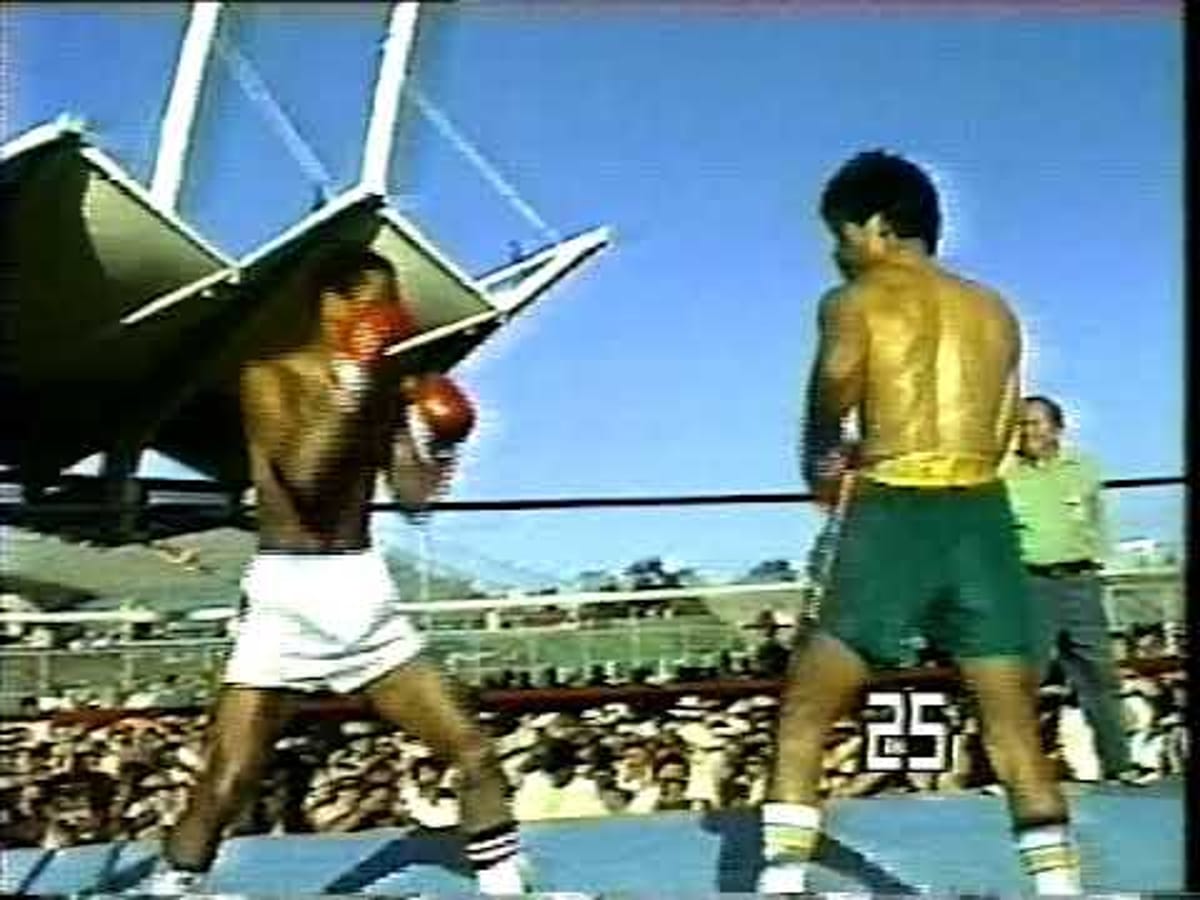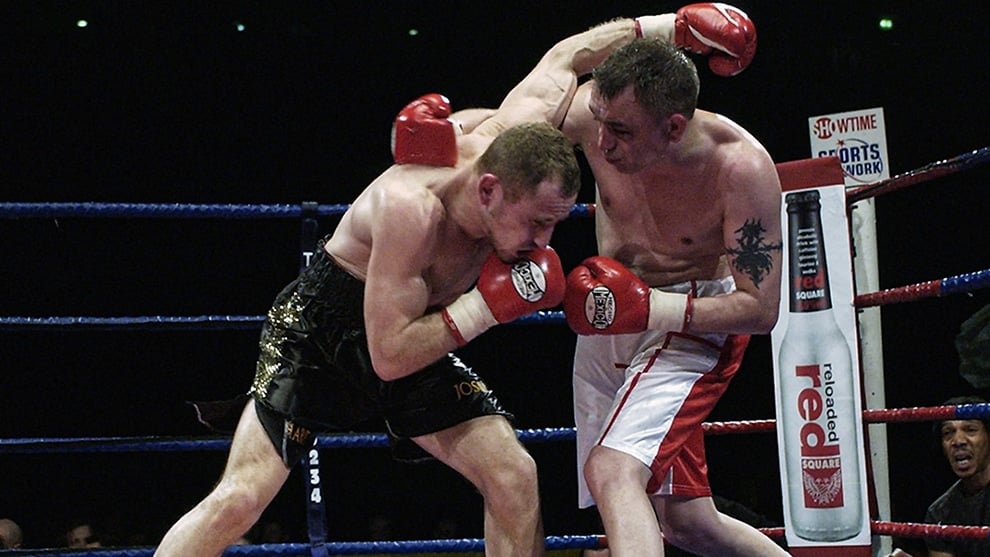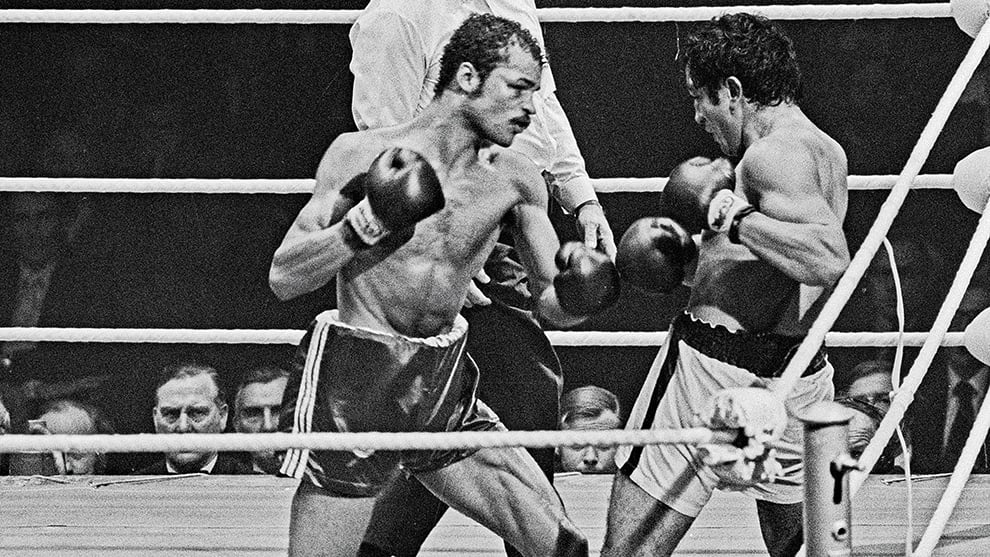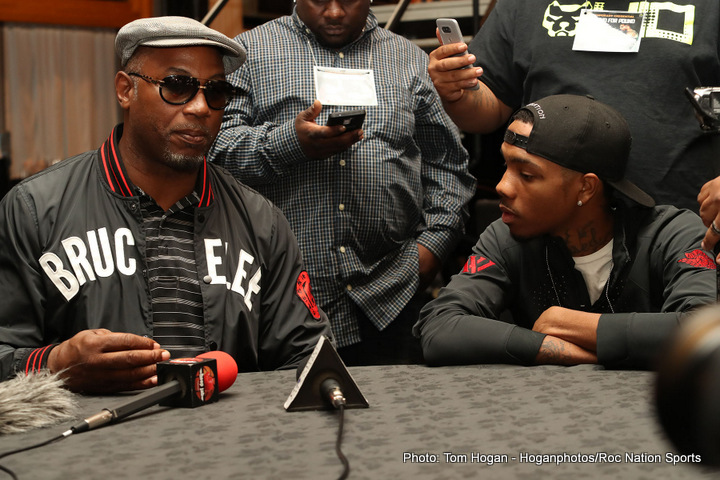Boxing History
King Charles! – The great welterweight champion Palomino turns 75
Published
4 months agoon

A novel film is in the works about former welterweight champion Carlos Palomino, and the former champion, who has been working on his acting skills since hanging up his gloves, certainly has a story to tell. Today, “King Carlos” turns 75, yet he looks, sounds and feels much younger. Palomino is one of the greatest living fighters and is in great shape; the Mexican, who was born into poverty, has successfully navigated all the perilous traps the ring can throw at any fighter.
And although Palomino lost the two biggest fights of his career, those being against Roberto Duran (L10) and Wilfred Benitez (LS15 – “the hold-up” says Palomino), the man born in Sonora, Mexico, certainly won a few massive ones. Palomino was for a while the guy who broke British hearts; his victories over John H. Stracey (from whom Palomino took the WBC welterweight title) and Dave “Boy” Green (the man who Palomino claims hit him the hardest he’s ever been hit) saw him defeat two of the most popular British welterweights of the day.
Holding the crown for three years, during which he managed to hold an impressive seven titles, Palomino showed just how good he was. Surprisingly athletic (Carlos ran a ton of miles in training, which was good for his gas tank), Palomino was a fearsome puncher, had a great chin, and Palomino was a fighter who often came in with power in the latter stages of the fight, with the 15-round distance being what he was most comfortable with and it was a shame to see him no longer in the sport.
Palomino was never stopped and faced both peak Duran (Duran Palomino fought in June 1979, it was a non-title fight, it may have just been the best version of Duran the world had ever seen) and peak Benitez (who Carlos had lost his title to just five months before moving on to Roberto). The wins over Armando Muniz (twice) came during his reign and Palomino, win or lose, always won over fans.
After learning his craft and getting into great shape in the military—Palomino won the AAU welterweight national title by defeating future Olympic gold medalist Sugar Ray Seales—the 23-year-old turned pro. Soon the main attraction in Los Angeles at the Olympic Auditorium, the hungry, determined, and always perfectly prepared Palomino was climbing the ranks. After a close points loss to Andy Price in August 1974, Palomino boxed to a draw with Zovek Barajas (followed by a win over Barajas) and Hedgemon Lewis before heading to London to challenge Stracey in June 1976. Palomino broke Stracey, his body aching with shots tearing the fight away from the defending champion.
The British fans loved Palomino, despite beating their hero. Palomino had a way of winning over the crowd with his easy-to-watch fighting style and his sheer class and humble personality. Palomino stopped Muniz slow, while Muniz survived a wobble against Green, then stopped him slow. The fight proved to be another great visit to London. Finally, after a second victory over the teakwood tough Muniz, this time by decision, Palomino was dethroned by Benitez in Puerto Rico.
Then came the battle with the utterly terrifying, fully tuned Duran, and Carlos, who had promised himself he would come out at the age of 30, kept his word after watching it go to the final bell against Duran, who would have been a worse man, quit that night when he met him in Novel York.
But the comeback came, quite amazingly, in 1997. Palomino, now 48 but looking considerably younger, had four good wins over decent fighters before dropping a decision to Wilfredo Rivera in May 1998. Palomino retired for good with a 31-4-3(19) record. In retirement, after his in-ring career, Carlos starred in a memorable beer commercial and appeared on TV shows like “Taxi” and “Star Trek: Voyager.”
Palomino was inducted into the International Boxing Hall of Fame in the summer of 2004.
Carlos Palomino, a great fighter and a great person, who no one in the sport has a bad word to say about him, is right up there with all the Mexican fighters we respect so much. This upcoming biopic – titled “Carlos Palomino: The Movie” – should be something really special.
You may like
Boxing History
Boxers who won first places in 100 competitions
Published
2 days agoon
November 24, 2024
AFTER several years of trying to add competitions between 1900 and 1904, I have now completed my records to include all competitions that have taken place on British soil since 1900. This allowed me to calculate exactly how many professional boxers living in the UK have had 100 or more professional competitions and by my calculations the number is 1,017.
I remember reading BN in 1975, when Battersea’s Ray Fallone had his hundredvol fight and then it seemed like it would probably be the last. However, at the turn of the 20th century, as ‘journeyman’ players became more regular and played an critical role in the game, a further eight emerged, including Winston Burnett, Seamus Casey, Dean Bramhald, Des Gargano and Peter Buckley. . A further 41 people have since joined the lists and Liam Griffiths from Bognor Regis, now competing in 99 competitions, looks set to be next.
Winston Burnett
What every centurion has had in common since Fallone is a very low win rate because they were all journeymen. This is a huge change from what was there before. Only 16 boxers who turned professional between 1940 and 1979 became centurions, but 10 of them had winning records, and of the six who did not, two of them, Tommy Tiger and Jack Johnson Cofie, were immigrants, which represents a warrior category that often appeared on the right side of the bill.
As you might expect, most of the centurions, 678 in all, turned professional in the 1920s (444) or 1930s (234), and 366 of these boys won more than half of their competitions.
Three players, Nipper Shaylor from Birmingham, Herbie Fraser (Westbourne Park) and Alf Barrett (Coatbridge) managed to fit their entire career into a four-year period. The best of them was Herbie Fraser. His 123 competitions lasted from 1931 to 1935, and he retired at the age of 22. Nipper Shaylor had 110 contests and less than 40 of them were entered in the pages BNshowing how hard it is today to put these records together.
Seaman Tommy Watson of Newcastle, who was British featherweight champion from 1932 to 1934 and who fought the great Kid Chocolate for the world title at Madison Square Garden in 1933, had the highest win rate of any centurion, winning 113 of 124 contests over a 10-year career. Right behind him are Hal Bagwell, Jock McAvoy, Jimmy Wilde, Peter Kane, Tom Smith (Sunderland) and the great Len Harvey.
There are 78 fighters who have fought at least two hundred fights, and 10 of them have fought three hundred or more. Inevitably at the top of the list is Leicester’s Len Wickwar with 470. Len has fought more times than any other boxer, in any era, anywhere in the world and is in a league of his own. Len died in 1980 on exactly the same day as his stablemate, George Marsden of Nottingham, who is second on my list with 375 competitions. The latest player to crack the top 300 is, of course, Nuneaton’s Kristian Laight.
Before 1925, it was quite reasonable and normal for soldiers to continue an busy boxing career, and there were many excellent fighters in both the Navy and Army, among them 14 centurions. If I were to single out just one of them as representative of their type, it would be Corporal Zimmer of the Hampshire Regiment, serving from 1909 to 1922 and winning 75 of his 151 competitions. He boxed everywhere. Another profession that spawned centurions was coal mining.
There were many of them from South Wales, the Midlands and the North East, but despite long recordings they didn’t make much money from the game, and many of them I got to know personally in the 1970s. They were proud of their careers and are still proudly on my centurion list.

On October 20, London’s Connaught Rooms restaurant hosted a full house for a luncheon in tribute to John Conteh, MBE.
The event was organized by London-based EBA Secretary/Treasurer Ray Caulfield and long-time LEBA benefactor Scott Ewing (John is LEBA Vice-President) to mark the 50th anniversary.vol anniversary of John winning the vacant WBC delicate heavyweight world title after defeating Argentine Jorge Ahumada on October 1, 1974.
But as Scott Ewing said in his opening speech, it was much more about John Conteh the person than the boxer. “John did so much for so many people,” Scott said.
He then described John’s work with Alcoholics Anonymous (“He brought so many back”) and the Variety Club, noting that John was only the second person (besides Jimmy Tarbuck) to be named captain of the Variety Club golf team. “He travels all over the country visiting EBA – he’s a great ambassador,” Scott said, explaining that John was also a major supporter of the Ringside Charitable Trust.
MC John McDonald did a great job all afternoon. He introduced many boxing personalities including world champions Frank Bruno MBE, Steve Collins MBE, Maurice Hope MBE and Colin McMillan BEM. (Bruno received thunderous applause, as did Michael Watson MBE.) There were also stars from other sports, including: Charlie George (football) and Phil Taylor (darts). As you can imagine, LEBA was well represented. I was also delighted to see EBA Croydon chairman Pat Doherty and Brighton stalwart Harry Scott.
Former European and Commonwealth heavyweight champion (and LEBA member) Derek Williams paid tribute to Conteh, describing him as a “true boxing legend”. “Your name has stood the test of time,” Derek said, noting that John had to overcome many challenges and obstacles, and in doing so, he “paved the way for other black warriors.” He said John had “made his mark on boxing” and described him as “boxing royalty”, concluding simply: “Thank you for everything you’ve done.”
We saw a video of John in action – two KOs early in his career, his 12thvol– a round of stoppage of the German Rudiger Schmidtke in the fight for the European delicate heavyweight crown, his two fights with the tardy Chris Finnegan (the first brought John the Briton and Commonwealth titles). And finally, Jorge Ahumada scores those great points.
I was ringside at Wembley that night. As for the BN staff, I was tasked with doing a preview of Conteh-Ahumada and I chose Ahumada, but ended with, “Prove me wrong, John.” And I have never been happier to be proven wrong! John’s brilliant performance really made me feel proud to be British.
A segment of John’s This Is Your Life (a very popular long-running TV show) was also filmed, in which Paul McCartney paid tribute to his fellow Liverpool native, and tributes from boxers who were unable to attend the event were also filmed. These included former world champions Johnny Nelson, Ricky Hatton and Jim Watt – as well as a tribute from boxing writer and broadcaster Adam Smith, who described John as “one of the greatest British fighters produced since [Second World] War.”
British boxer John Conteh during his WBC delicate heavyweight title fight against Argentine Jorge Ahumada at Wembley, October 1, 1974. Conteh won the fight on points and was crowned world champion. (Photo: Keystone/Hulton Archive/Getty Images)
There was a very successful auction, conducted partly by Ray Caulfield and Scott Ewing and partly by John himself. John has an excellent reputation as an auctioneer at charity events and was in excellent shape. Entertainment was provided by Muhammad Ali Jr, who had everyone laughing with his impressions of his father, and comedian Bobby Davro.
As a nice gesture, John was given his WBC championship belt back – and in a low, modest speech, John thanked everyone for coming. He thanked his family, of which there was a lot – including his wife Veronica (they have been together for 50 years) and children James and Joanne. He also thanked Charles Atkinson, coach at Kirkby ABC, who started John on the path that ultimately led to the world title.
A wonderful tribute to a true boxing legend – and congratulations are in order to Ray Caulfield and Scott Ewing. These events don’t organize themselves
Boxing History
On this day: Lennox Lewis righting the wrong he committed in South Africa by hitting out at Hasim Rahman
Published
1 week agoon
November 17, 2024
Talk about pole work or a knockout when it matters most. Revenge Knockout. On this day in 2001, heavyweight great Lennox Lewis did the job he should have done when he first met Hasim Rahman. Instead, in April this year in South Africa, an ill-prepared (mainly for the altitude) Lewis was run over by a huge right hand from “Rock” Rahman. Rahman’s fifth-round KO victory is now seen as one of the greatest upsets in heavyweight history.
But Lewis, who ended up brawling with Rahman in a TV studio as the second fight approached, had sweet revenge. And it meant so much to Lewis, an avid chess player, that his KO would come sooner than Rahman’s.
They met at Mandalay Bay in Las Vegas, and the fight was dubbed “The Final Judgment”. Lewis scored his most satisfying KO of his career.
Lewis, this time fit and piercing, was seven years older at 36 and yet, as it turned out, still close to his best. Rahman (35-2(29)) held the title for seven months and then it was all over. Lewis, 38-2-1(29) entering, lowered the sonic boom in round four.
After inflicting a minor cut above Rahman’s eye in the first round, Lewis also went through the next two rounds. Then, in round four, Lewis landed a brutal left-right combination to the head that sent Rahman’s senses into orbit. Rahman fell, tried to get up, and then fell again. It was the kind of ugly, humiliating knockout defeat that all fighters dread.
Lewis argued with him after the fight, calling Rahman “Has-been Rahman”.
Lewis exacted savage revenge, and while Rahman’s KO was stunning in the first fight, Lewis’ thunderous and thunderous KO made us all almost forget what happened in the first fight. Lewis scored many great knockouts during his ring career, including knockout/stoppage wins over Razor Ruddock, Frank Bruno, Andrew Golota, Shannon Briggs, Michael Grant, Frans Botha and Mike Tyson.
But the ice work Lennox did on that day some 23 years ago is one of his most special.

Keyshawn Davis Mom KEEPS IT 100 on KNOCKING OUT Gustavo Lemos & 3 SONS FIGHTING on SAME CARD

Rockin Fights 49: Boxing Results from The Paramount

‘JAKE PAUL VS MIKE TYSON WAS NOT BOXING!’ – Frank Warren says ‘SWERVE BETERBIEV’
Trending
-

 MMA6 months ago
MMA6 months agoMax Holloway is on a mission at UFC 212
-

 Interviews2 months ago
Interviews2 months agoCarl Froch predicts that Artur Beterbiev vs Dmitry Bivol
-

 Interviews1 month ago
Interviews1 month agoArtur Beterbiev vs Dmitry Bivol
-

 MMA6 months ago
MMA6 months agoCris Cyborg ready to add a UFC title to her collection
-

 MMA6 months ago
MMA6 months agoThe Irish showed up in droves at the Mayweather-McGregor weigh-in
-

 Boxing4 months ago
Boxing4 months agoLucas Bahdi ready to test his skills against Ashton Sylve
-

 Interviews6 months ago
Interviews6 months agoI fell in love with boxing again
-

 Opinions & Features2 months ago
Opinions & Features2 months agoDmitry Bivol: The story so far



